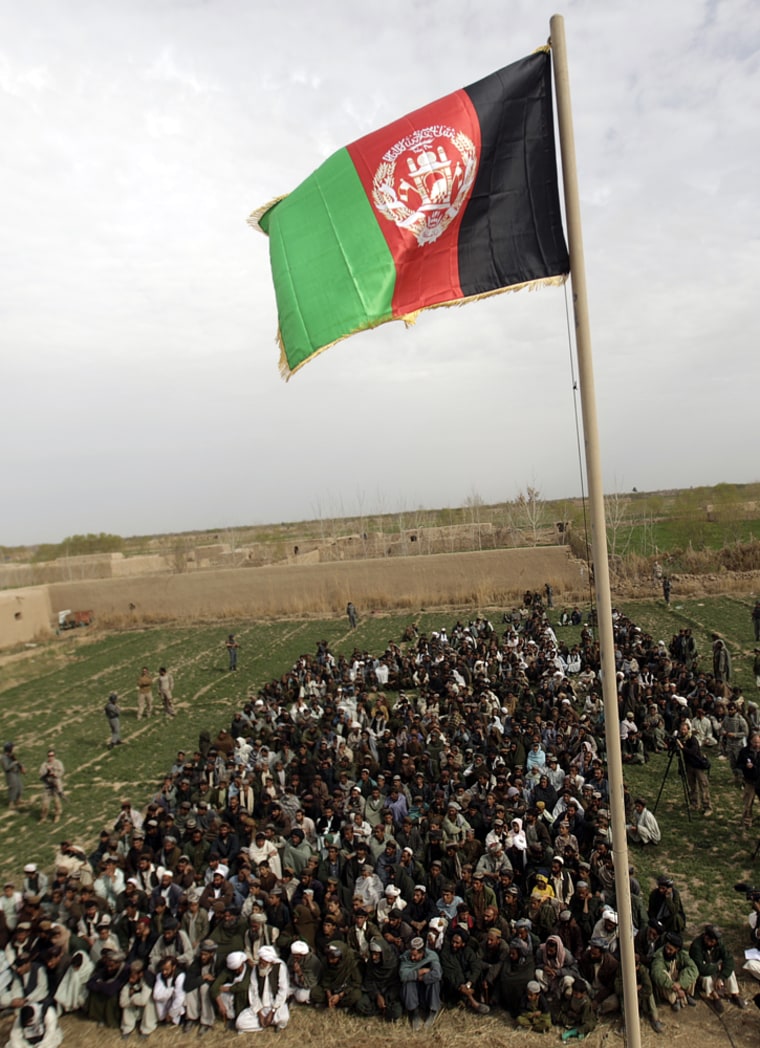The Afghan government took official control of the southern Taliban stronghold of Marjah on Thursday, installing an administrator and raising the national flag while U.S.-led troops worked to root out final pockets of militants.
The ceremony was held in a central market as U.S. Marines and Afghan troops slogged through bomb-laden fields in the north of the town. The Marines and their Afghan partners are trying to secure a 28-square mile area believed to be the last significant pocket of Taliban insurgents in Marjah.
Militants and allied troops are still getting caught up in gunfights in some areas, NATO said.
But the number of residents returning has increased in recent days, shops have opened to sell telephones and computers alongside fresh fruit and vegetables, and officials hailed the installation of Abdul Zahir Aryan as the town's administrator as a key sign of progress.
Some 700 residents gathered to see Aryan formally appointed as the top government official in Marjah, along with government officials and Brig. Gen. Larry Nicholson, commander of U.S. Marines in Marjah, according to officials at the event.
Aryan and a team of advisers held their first meeting in the town Monday and have been staying overnight in a building there since Tuesday, said Marlin Hardinger, the senior U.S. government representative for Helmand province, which contains Marjah.
"Today's event was the civilian Afghan government re-establishing itself officially in front of the local residents," Hardinger said. The Afghan army had previously raised the country's green-and-red flag nearby, but that was only a claim of military control over that neighborhood, he said.
'Will work for all'
The ceremony opened with a reading from the Quran, and then Aryan and Helmand Gov. Gulab Mangal pledged to those gathered they were ready to listen to their needs and eager to provide basic services that they didn't have under the Taliban.
"I want to find jobs for those youths who aren't Taliban and those who are. I will work for all of them," Mangal said.
Asking for peace and stability, residents who attended the ceremony said they wanted Afghan and NATO forces to quickly clear the bombs planted by insurgents on Marjah's roads, fields, and compounds so they could return home.
After the ceremony, the generals and high-level officials departed in helicopters, but Aryan remained.
The mass assault in southern Helmand province, with 15,000 NATO and Afghan troops, is the largest military operation in Afghanistan since the U.S.-led ouster of the Taliban regime in 2001.
NATO's strategy is to drive Taliban militants from the town, which had served as a logistical base and drug trafficking hub, restore the Afghan government's presence, and rush in public services in a bid to win over the confidence of local communities.
In the north Thursday, the Marines' progress was slowed by difficult terrain with no roads, few tracks and many hidden mines, but there was no gunfire all day. Several armored vehicles fell into irrigation canals while others were damaged by roadside bombs.
Hidden bombs
Several residents told Marines the Taliban were pulling back as NATO and Afghan troops advanced. It appeared insurgents were choosing not to engage in fighting, but instead trying to delay troops with planted bombs.
"I'd expect they can't keep this up for long," said Lima Company commander Capt. Joshua Winfrey, adding that he expected insurgents will soon hold their ground and fight.
About 100 fighters are believed to have regrouped into the area known as Kareze, according to commanders with the 3rd Battalion, 6th Marines Regiment.
In a sign that NATO's push to win over the population may be gaining traction, bomb tips from residents have increased by nearly 50 percent, the alliance said.
As the offensive closes in on its second week, 13 NATO troops and three Afghan soldiers have been killed, according to military officials. Eighty NATO troops have been wounded, along with eight Afghans.
At least 28 civilians have been killed, including 13 children, according to the Afghan human rights commission.
The civilian toll has raised fears that NATO may lose the support of the population even as it drives out the Taliban. The deaths come although NATO has said its priority is protecting the civilian population and has adopted strict rules to prevent casualties.
A spokesman for the Afghan Defense Ministry said both the Afghan government and NATO troops realized they had to be realistic and accept that there would be civilian deaths.
"Preventing civilian casualties is our biggest challenge," Gen. Mohammad Zahir Azimi told reporters in Kabul. "You should not expect zero casualties, either from our side or from the international forces. That will only happen when the fighting is over. And we are all trying to make that happen."
NATO spokesman Brig. Gen. Eric Tremblay, speaking alongside Azimi, urged Afghans to recognize that international troops are putting themselves in greater danger in order to try to protect civilians.
"We are going beyond the laws of armed conflict by increasing our risk," Tremblay said.
